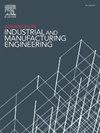Toward generalizable machine learning prediction of downskin surface roughness in laser powder bed fusion
IF 3.9
Q2 ENGINEERING, INDUSTRIAL
Advances in Industrial and Manufacturing Engineering
Pub Date : 2025-05-01
DOI:10.1016/j.aime.2025.100163
引用次数: 0
Abstract
Downskin surface quality of laser powder bed fusion (L-PBF) remains a challenge due to the complex, multi-scale physics governing it. While numerical or experimental approaches alone can be significantly resource intensive, data-driven approaches such as machine learning (ML) have the potential to be more practical. However, the generalizability of ML models currently reported in literature is unclear; few ML models can predict reliably outside of their training domain. This study addresses these challenges by (i) demonstrating a downskin surface roughness classification model, trained on the largest reported dataset for downskin roughness (400 downskin specimens spanning five builds and two ferrous alloys) and (ii) conducting a thorough investigation of the model’s generalizability. Additionally, this study highlights critical issues such as data imbalance, generalization to unseen data, and the importance of rigorous evaluation. By implementing robust ML practices, we focused on model performance across different training and evaluation domains. Our findings indicate satisfactory performance when using the more conservative balanced accuracy metric, achieving about 95% inter-domain and 83% intra-domain accuracy. Although there is still room for improvement, these results demonstrate a significant reduction in the risk of overfitting, thereby enhancing the classifier’s generalizability. This work underscores the importance of methodological rigor in machine learning applications, advocating for greater attention to data treatment and evaluation strategies. This approach may ultimately lead to more effective and usable ML models. The data-centric results indicated that (i) physics-informed features can improve performance during domain shifts, and (ii) increased the size and variety of datasets allows even computationally light models to achieve favorable performance.
激光粉末床熔合中下皮表面粗糙度的广义机器学习预测
由于控制激光粉末床熔合(L-PBF)的复杂、多尺度物理特性,下皮表面质量一直是一个挑战。虽然单独的数值或实验方法可能会占用大量资源,但数据驱动的方法(如机器学习(ML))有可能更加实用。然而,目前文献中报道的ML模型的泛化性尚不清楚;很少有机器学习模型可以可靠地预测其训练域之外的情况。本研究通过以下方式解决了这些挑战:(i)展示了一个下表层表面粗糙度分类模型,该模型在最大的下表层粗糙度报告数据集上进行了训练(约400个下表层样本,跨越五种建筑和两种黑色合金),(ii)对模型的可泛化性进行了彻底的调查。此外,本研究强调了关键问题,如数据不平衡、对未见数据的概化以及严格评估的重要性。通过实现健壮的机器学习实践,我们专注于不同训练和评估领域的模型性能。我们的研究结果表明,当使用更保守的平衡精度度量时,性能令人满意,域间精度约为95%,域内精度约为83%。尽管仍有改进的空间,但这些结果表明,过度拟合的风险显著降低,从而增强了分类器的可泛化性。这项工作强调了机器学习应用中方法严谨性的重要性,提倡更多地关注数据处理和评估策略。这种方法可能最终导致更有效和可用的ML模型。以数据为中心的结果表明,(i)物理信息特征可以在域转移期间提高性能,(ii)增加数据集的大小和种类,甚至可以使计算轻的模型获得良好的性能。
本文章由计算机程序翻译,如有差异,请以英文原文为准。
求助全文
约1分钟内获得全文
求助全文
来源期刊

Advances in Industrial and Manufacturing Engineering
Engineering-Engineering (miscellaneous)
CiteScore
6.60
自引率
0.00%
发文量
31
审稿时长
18 days
 求助内容:
求助内容: 应助结果提醒方式:
应助结果提醒方式:


